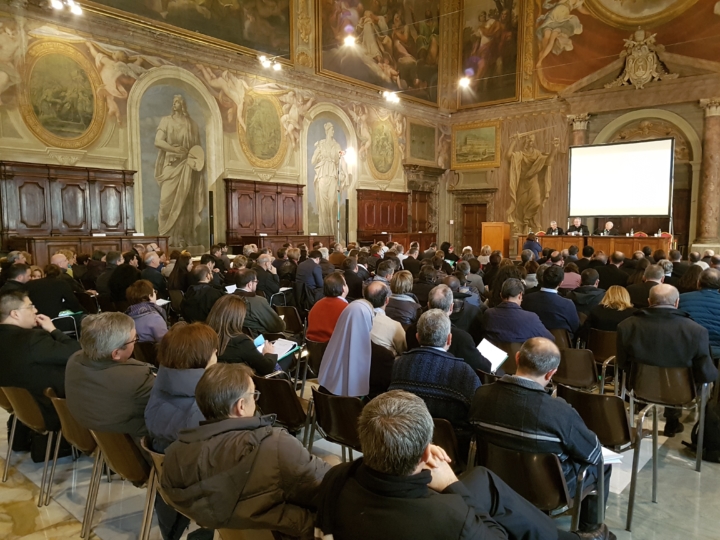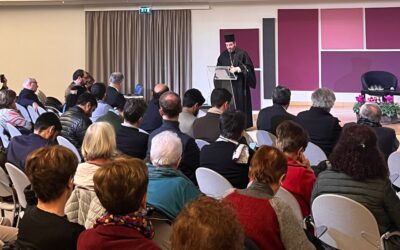 On the first day of the week dedicated to Christian unity (18 – 25 January), under the splendid vault frescoed in just a hundred days by the famed painter Vasari, in the renaissance Roman Chancery building, an invocation to the Holy Spirit opened the study day which the ecclesial Movements and Communities dedicated to “Charism and Institutions.” Promoted by the Focolare Movement, New Horizons, Family of Hope, the Catholic Shalom Community, The Emmanuel Comminity and Pope John 23rd Community, together with upper education Evagelii Gaudium” Centre of the “Sophia” University Institute and under the patronage of the The Canon Law Association of Italy, the day represented a new phase of the deep “affective and effective synergy” between Movements and ecclesial realities, as underlined by opening speech of Maria Voce who represented all the promoters: “We are committed to facing, day after day, coherently with all the charisms received, the challenges that lead the way towards the fullness of Christian life and the perfection of charity, in the effort to enhance communion within our Movements and between us all.” At the same time, the day was the occasion to deepen a specific theme regarding the relationship between charisms, gifts of the Spirit, and the institutional forms, in the light of the document of the Congregation for the Doctrine of the Faith, “Iuvenescit Ecclesia” (May 2016), which defines the charismatic and hierarchic gifts as “co-essential:” while “the presence of the institutions guarantee that the announcement of the Gospel will never be lacking – underlined Cardinal Kevin Joseph Farrell, President of the Council for the Laity, Family and Life – the presence of the charisms guarantee that there will always be those who receive them with openness of heart.” After their birth in the heart of the Church, “with that bit of surprise and upheaval which their unexpected and unprecedented appearance had provoked,” and their approval, often the fruit of a long and painful pathway, now the Movements – said Piero Coda, Rector of the IUS – “are fording a third phase, where charismatic effervescence is committed to finding the suitable channels for a balanced institutionalisation (…) to express at best their own specific contribution.” A still open issue regards the nature of the ecclesial movements, which in force of their founding charism do not demand a new juridical form of association (the Codes of Canon Law in force do not contain the terms “ecclesial movements and communities” and therefore these are lawfully placed under the “associations of the faithful), but also in the distinctions of juridical nature able to support at best the charismatic richness and specificity of each. In fact, we have to take into account, that these “associations” are made up of laity, priests and religious, forming what Bishop Christoph Hegge, Auxiliary Bishop of Münster defines a “communitarian unity,” with reference to the “communitarian testimony” which all the members of the movement, with “resilience and flexibility of belonging,” offer together as the people of God, accepting and living the proclamation of the Church in our time. On the need to differentiate the juridical statutes regarding the variety and specificity of the charisms, His Eminence Luis Navarro, Rector of the Pontifical University of Santa Croce, said “There is no unitary juridical solution. Each needs to tailor a made-to-measure vest.” But to do so, we need to “know and study a charism in its concrete ecclesial life.” “In the history of the Church, the Movements have always been the answer to a need,” affirmed Laurent Landete, married and father of six children, the French leader of the Emmanuele Community, among the participants of the afternoon round table dedicated to the presentation of the Movements and ecclesial realities operating at all latitudes. If the future of their Statutes is the basic theme of the reflection, the freshness, actuality and variety of the ways with which they operate, driven by the Spirit, in the streets of the world, arouse marvel and stupor, as in face of the colours and perfumes of an immense garden in Spring.
On the first day of the week dedicated to Christian unity (18 – 25 January), under the splendid vault frescoed in just a hundred days by the famed painter Vasari, in the renaissance Roman Chancery building, an invocation to the Holy Spirit opened the study day which the ecclesial Movements and Communities dedicated to “Charism and Institutions.” Promoted by the Focolare Movement, New Horizons, Family of Hope, the Catholic Shalom Community, The Emmanuel Comminity and Pope John 23rd Community, together with upper education Evagelii Gaudium” Centre of the “Sophia” University Institute and under the patronage of the The Canon Law Association of Italy, the day represented a new phase of the deep “affective and effective synergy” between Movements and ecclesial realities, as underlined by opening speech of Maria Voce who represented all the promoters: “We are committed to facing, day after day, coherently with all the charisms received, the challenges that lead the way towards the fullness of Christian life and the perfection of charity, in the effort to enhance communion within our Movements and between us all.” At the same time, the day was the occasion to deepen a specific theme regarding the relationship between charisms, gifts of the Spirit, and the institutional forms, in the light of the document of the Congregation for the Doctrine of the Faith, “Iuvenescit Ecclesia” (May 2016), which defines the charismatic and hierarchic gifts as “co-essential:” while “the presence of the institutions guarantee that the announcement of the Gospel will never be lacking – underlined Cardinal Kevin Joseph Farrell, President of the Council for the Laity, Family and Life – the presence of the charisms guarantee that there will always be those who receive them with openness of heart.” After their birth in the heart of the Church, “with that bit of surprise and upheaval which their unexpected and unprecedented appearance had provoked,” and their approval, often the fruit of a long and painful pathway, now the Movements – said Piero Coda, Rector of the IUS – “are fording a third phase, where charismatic effervescence is committed to finding the suitable channels for a balanced institutionalisation (…) to express at best their own specific contribution.” A still open issue regards the nature of the ecclesial movements, which in force of their founding charism do not demand a new juridical form of association (the Codes of Canon Law in force do not contain the terms “ecclesial movements and communities” and therefore these are lawfully placed under the “associations of the faithful), but also in the distinctions of juridical nature able to support at best the charismatic richness and specificity of each. In fact, we have to take into account, that these “associations” are made up of laity, priests and religious, forming what Bishop Christoph Hegge, Auxiliary Bishop of Münster defines a “communitarian unity,” with reference to the “communitarian testimony” which all the members of the movement, with “resilience and flexibility of belonging,” offer together as the people of God, accepting and living the proclamation of the Church in our time. On the need to differentiate the juridical statutes regarding the variety and specificity of the charisms, His Eminence Luis Navarro, Rector of the Pontifical University of Santa Croce, said “There is no unitary juridical solution. Each needs to tailor a made-to-measure vest.” But to do so, we need to “know and study a charism in its concrete ecclesial life.” “In the history of the Church, the Movements have always been the answer to a need,” affirmed Laurent Landete, married and father of six children, the French leader of the Emmanuele Community, among the participants of the afternoon round table dedicated to the presentation of the Movements and ecclesial realities operating at all latitudes. If the future of their Statutes is the basic theme of the reflection, the freshness, actuality and variety of the ways with which they operate, driven by the Spirit, in the streets of the world, arouse marvel and stupor, as in face of the colours and perfumes of an immense garden in Spring.
Love you neighbour – today’s medicine!
Love you neighbour – today’s medicine!




0 Comments